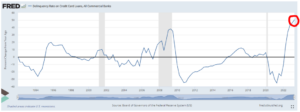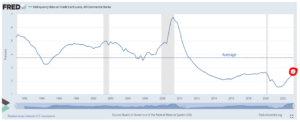Same data. Two very different headlines. One to scare you. One to calm you. Guess which one gets used?
In the last few days, four different colleagues at my firm sent me links to some financial blogs and posts that referenced the chart below from FRED – Federal Reserve Economic Data, the official website of the Fed – on credit card delinquency rates.

Delinquency rates – running late on payments – is an important indicator of whether the American consumer is starting to feel financially stretched, typically a bad omen for the health of the economy. Banks have to report their credit card delinquency rates quarterly.
The chart above shows the annual percentage change in these rates, going back 31 years. The most recent reading, the red circle that was often added for effect, was 50.5%. That’s right, a 50% increase in delinquency rates from a year ago. That, admittedly, is a notable spike.
The headlines, therefore, on all of these blog posts all were shouting with the same sheer panic:
Consumers Drowning in Debt –Delinquency Rates Go Through the Roof
Higher Rates Killing The Consumer — Delinquency Rates Worse Than The Great Financial Crisis.
Batten Down the Hatches — The Consumer is Overleveraged, Over Their Skis, and Over a Barrel.
You get the idea. [ Even my heart skipped a beat when I saw it, and I should know better.]
It actually gets worse. The comments on these blog posts showed that the doomsday “reporting” was working. Anybody who saw this chart was getting riled up. Nearly everybody jumped on the panic wagon, agreeing wholeheartedly with the premise of the scary headline. Higher interest rates were going to be the ruin of the economy, the consumer was going over a cliff, and the U.S. economy was, without a doubt, on the road to ruin.
Here’s the problem. That chart is completely misleading. Yes, commercial banks around the country did report to the Fed, as they are obligated to do, a delinquency rate on their credit card loans. The number was 2.77%. And yes, the delinquency rate did jump from a year ago. But the absolute level of delinquencies…well, that was a completely different story. See the chart below, which is over the same 31-year time frame.

It turns out that a delinquency rate of 2.77% is still notably low by historical standards. This is a GOOD thing, not a BAD thing. The consumer is not in trouble. They’re recording some of the lowest delinquency rates in the history of collecting this data. The latest reading, the red dot, was actually 26% lower than average. And you cannot even compare today to the height of the Great Financial Crisis in 2008 -2009. Unemployment is recording some of the lowest levels in 60 years. Wages are rising faster than the rate of inflation. Inflation, itself, is coming down significantly from a year ago. And the economy just posted GDP growth of 4.9%, one of the best numbers we’ve seen in over 20 years.
The headlines should have been saying this:
Everything’s OK – Consumer Delinquency Rates Still Well Below Normal.
The Consumer Is Fine – No Worries
Delinquency Rates Up, But No Need To Panic.
But honestly, who would click on those headlines?
Same data. Two very different tales. One designed to scare you, telling you it’s the worst of times. While the other, more accurate in my humble opinion, is telling you that things – while perhaps not the best of times – are still pretty OK.
About Pete Chiappinelli, CFA, CAIA, Chief Investment Officer
Pete is Chief Investment Officer at the firm. He is focused primarily on Asset Allocation in setting strategic direction for client portfolios.
This report is the confidential work product of Ballentine Partners. Unauthorized distribution of this material is strictly prohibited. The information in this report is deemed to be reliable. Some of the conclusions in this report are intended to be generalizations. The specific circumstances of an individual’s situation may require advice that is different from that reflected in this report. Furthermore, the advice reflected in this report is based on our opinion, and our opinion may change as new information becomes available. Nothing in this presentation should be construed as an offer to sell or a solicitation of an offer to buy any securities. You should read the prospectus or offering memo before making any investment. You are solely responsible for any decision to invest in a private offering. The investment recommendations contained in this document may not prove to be profitable, and the actual performance of any investment may not be as favorable as the expectations that are expressed in this document. There is no guarantee that the past performance of any investment will continue in the future.




